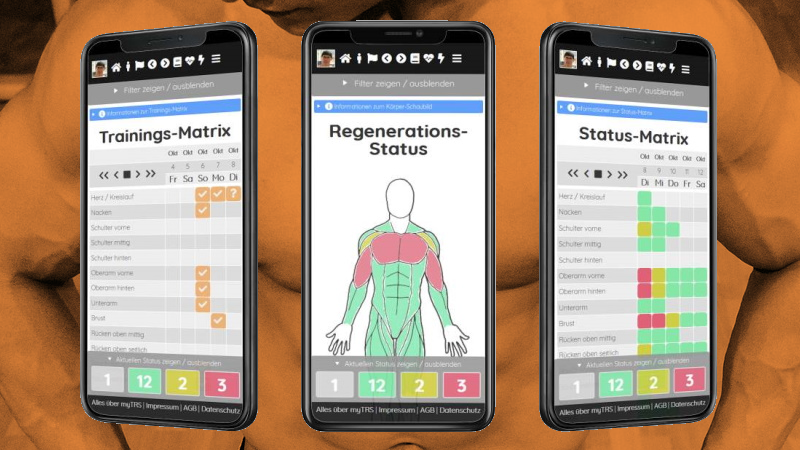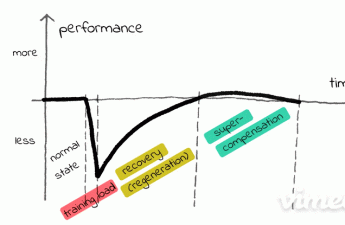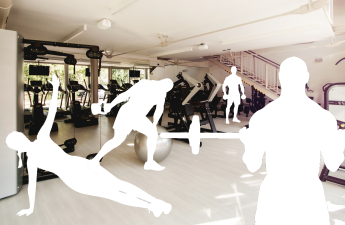Building muscle means increasing strength or muscle mass. In both cases, the training person is dependent on setting a build-up stimulus by means of hard training – and ideally at exactly the optimal time. Trying to do that for each muscle is what regeneration-based building training calls for.
How to build muscles? Exercise – again and again and …
Of course, you know yourself what it means to build muscles: train, train and train again. This is not completely wrong, but also not completely right. Because: The build-up only takes place after the trained muscle has recovered. And that takes one thing above all: time.
Muscle regeneration therefore plays a central role for the desired build-up success. Particularly unpleasant is the fact that one cannot clearly perceive the process of regeneration – and one is more or less dependent on assumptions. Are my biceps ready for the next intensive arm workout? Or are they still stressed from the back training of the last few days in such a way that a few more days are necessary for their recovery and the subsequent build-up?
The problem with all this is that if you train muscles too often over a long period of time, they become weaker instead of stronger. And in the worst case, the athlete gets into a state of overtraining, which is a heavy burden and brings with it a whole range of physical and psychological symptoms. Especially those who avoid direct intervention in their own hormonal balance are increasingly confronted with this danger: Natural bodybuilders are on a constant tightrope walk between maximum training stimuli and the threat of overtraining – and are therefore constantly looking for solutions to overcome this challenge.
When to train what again? Regeneration-based build-up training and the right timing
So it’s all about the question of what to train again and when. Or actually: what you should train again TODAY. Because the plans for the next few days are always just plans, and whether the reality of work and leisure will also play along, remains to be seen. But today you are with your dumbbells, and today it is to determine how you should use your training time optimally.
You have probably already heard about the concept of supercompensation: First, the trained muscle is stressed during the performed exercise and loses its performance capacity, and then it has to recover before it reaches the previous level of performance again. And now the observation of many athletes: for a short time after complete recovery (regeneration), the muscle is capable of more intense efforts than before. So it is precisely in this phase of increased performance that the next hard training stimulus must be set.
The difficulty in this matter: The trained exercises usually do not load only one muscle group in isolation, but several. And they do so in different load distributions. Thus, it is not so easy to guess when which muscle should be recovered.
Why to train regeneration-based? About the importance of complete recuperation
But isn’t it enough to rest the previously trained muscle for 24 or 48 hours? Isn’t it then already sufficiently recovered to be able to be trained again?
Well, if the previous workout was a relatively easy one, then this time may be sufficient. However: In the build-up training it is usually not like a children’s birthday party, but the intensity of the completed exercises is relatively high. Sets are performed until muscle failure or – with appropriate tricks and techniques – beyond. And even if you don’t follow the HIT system (High Intensity Training), the muscles in the build-up phase are usually so battered that they simply need more time to recover.
And what’s more: As early as the beginning of the nineties, studies addressed the observation that different muscles also recover at different speeds: So it’s probably not very advisable to let every muscle group rest for so-and-so many hours.
What is the best split program? Regeneration-based build-up training as a guarantee for variety
In response to the problem of muscle recovery, countless split programs have been developed over the years that have one thing in common to begin with: They only ever load a part of the entire body per workout. In contrast to full-body workouts, the athlete can therefore use his available energy for specific muscle groups without always having to train the entire body. And in this way, a muscle is specifically loaded two to three times a week.
But which muscles to train on which days? A wide variety of split programs have been and continue to be presented in the relevant magazines. What they all have in common is that it is specified on which day of the week what is to be trained. The challenge here: to arrange your own daily routine so that this is possible. Most people know that: It doesn’t always work.
Regeneration-based build-up training enables a different approach here: The muscles to be trained are always those that are already prepared for the next hard training session. Which muscles these are depends on the exercises performed in the previous days. Were bench presses performed for the chest? Then probably the triceps are still loaded as well as the anterior deltoids. Or was it flyes for the chest? Then perhaps also in this case the front shoulder will still need rest, but the triceps were not challenged at all and could be subjected to a workout today.
This automatically results in variety in the training: Every day is different. And that’s why every day offers different exercises that suit the current state of regeneration.
Fashion trend or permanent solution? Regeneration-based build-up training as a lifelong companion
Regeneration-based build-up training is not something you do because everyone else is doing it. This form of training is rather a special view of the processes in one’s own body when it comes to muscle building: After stress comes regeneration, and then the time of increased performance level.
Basically, regeneration-based build-up training could be described as a philosophy: One considers the current condition of one’s own body as the basis for one’s own, completely individual training, which looks different every day. And since this philosophy is all about always giving sufficient rest to the structures that were previously under hard strain, regeneration-based build-up training can take on the role of a lifelong companion – a companion that is intended to help prevent the body from being overtaxed.
Regeneration-based build-up training – a logical consequence?
Alright, enough said – let’s think the whole thing through again for a moment: We want to build up our muscles. More specifically: that they gain strength or mass. To achieve this, we set a build-up stimulus with suitable exercises, which initially weakens the different muscles to varying degrees. And only after this weakening has been completely compensated, a short period of increased performance follows, during which the muscle should be challenged again – and not before.
The optimal next training of a muscle is therefore neither too early nor too late, because: if it is done too early, the regeneration processes or the build-up that is currently taking place will be disturbed or even aborted. If, on the other hand, it is done too late, the short window of increased performance is already closed again.
So what could be more logical than a consistent orientation of the training planning to one’s own load condition?
How to implement all this? Regeneration-based build-up training in practice
All the previously described relationships were for us the basis for our online tool myTRS. Because the considerations by which exercises which muscles were loaded how intensively, and when they are ready again for a next training due to their shorter or longer regeneration time – these considerations are rather difficult to make in the head, because the situation quickly becomes complex and confusing.
For this reason, we have developed the online tool myTRS (My Training Regeneration Status), which can be used as a tool for the practical implementation of the ideas of regeneration-based build-up training. And this even free of charge in case of a maximum of 100 recorded exercises.



